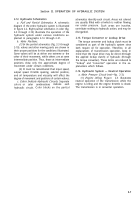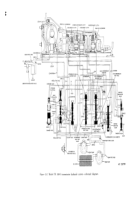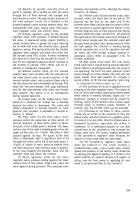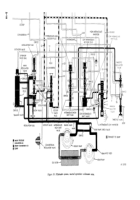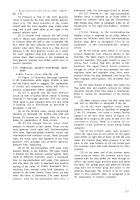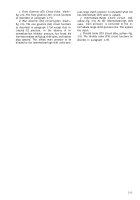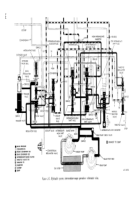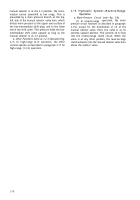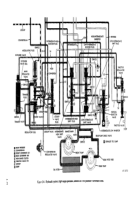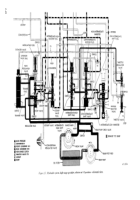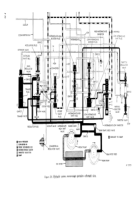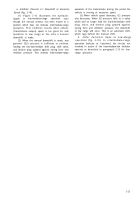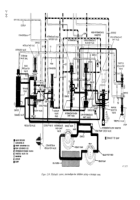TM-9-2520-254-34 - Page 26 of 126
g. Throttle (T) Circuit
(green, yellow — fig. 2-5).
The throttle (T) circuit functions as described in
paragraph 2-15g.
h. Inhibitor Pressure Circuit
(dotted red—fig. 2-
5). In intermediate range (selector at 1-2 position),
only the high-intermediate downshift inhibitor
circuit is charged.
It functions as described in
paragraph 2-15
h.
i. Lockup Clutch Circuit
(blue, white—fig. 2-5).
(1) The flow valve controls the lockup clutch
circuit when a shift from one range to another
occurs automatically or is made manually. In figure
2-5, the change can be considered as a manual
change from selector position 1 to selector position
1-2, or it can be considered as an automatic upshift
from 1 to 2 within selector position 1-2.
(2) The downward movement of the flow valve
(a (1) (c) and (d) above) releases the lockup clutch
temporarily and triggers the action of the trimmer
valve. The flow valve moves downward when the
shift has just occurred. It will stay downward until
the oncoming
clutch (intermediate range) is
partially pressurized.
(3) When the flow valve is downward, lockup
pressure is released. This is only temporary until
the oncoming range clutch is filled and main
pressure above and below the flow valve equalizes.
(4) Main pressure below the trimmer valve
quickly lifts the trimmer valve until oil escapes
through the exhaust port at the left. This reduces
main pressure flowing to the clutch being applied.
With negligible pressure above the trimmer plug,
main pressure flowing through the orifice
in
the
bottom of the trimmer valve forces the trimmer
plug upward, away from the trimmer valve. The
speed of its movement upward is influenced by
throttle valve (TV) pressure being faster at closed
throttle (para.
2-15 f(4)). The speed of its
movement likewise influences clutch apply pressure
initially. The higher TV pressure is, the higher
initial clutch pressure is.
(5) The trimmer valve remains open (oil
exhausting at left side) until the trimmer plug
reaches the top of its stroke. When the trimmer
plug stops, oil continues to flow upward through
the orifice in the bottom of the trimmer valve.
When pressure above and below the trimmer valve
is equalized, spring pressure pushes the trimmer
valve downward. This closes the exhaust port.
Main pressure increases significantly below the
flow valve to return the flow valve to its upward
position and lockup pressure is restored. Main
pressure is restored, at the same time, to the area
above the extender valve ball.
(6) When the extender valve ball is seated,
further flow of oil from tbe upper area of the
trimmer valve bore is prevented. Then, oil entering
the bore (from main), through an orifice, forces the
trimmer plug to the lower end of its bore. Then
main pressure increases to full value.
(7) The overall action of the trimmer is to
reduce clutch apply pressure momentarily after a
gear change to prevent shift shock. It does this by
gradually applying main pressure at a rate which is
influenced by throttle opening. The temporarily
reduced main pressure allows the clutch to slip
when it is initially applied.
2-17.
Hydraulic
System—High-Range
Operation (Selector at 1-2-3 Position
a. Main Pressure Circuit
(red—fig. 2-6.)
(1) Main-pressure circuit in high-range
(selector at 1-2-3 position) is the same as that for
intermediate-range (para 2-16a) except that line 4
is not charged, and the trimmer is not in operation.
(2) The absence of pressure in the high-
intermediate inhibitor circuit (fed by line 4) per-
mits the intermediate-high blocker plug, shift valve,
and shift plug to move upward. This connects main
pressure, at the intermediate-high shift valve, to the
high-range clutch line.
(3) When tbe trimmer is not acting, the flow
valve is upward and the trimmer is charged as
explained in paragraph 2-15a (12) and (13), above.
b. Converter-In Circuit
(yellow—fig. 2-6). The
converter-in circuit functions
as described in
paragraph 2-15b.
c.
Front Governor (G1) Circuit
(blue, black—
fig. 2-6). The front governor (G1) circuit functions
as described in paragraph 2-15c.
d. Rear Governor (G2) Circuit
(green, black—
fig. 2-6). The rear governor (G2) circuit functions
as described in paragraph 2-15d, except that in-
creased G2 pressure, in the absence of both in-
termediate-low and high-intermediate inhibitor
pressure, has shifted the transmission to high range.
This occurred when G2 pressure forced the low-
intermediate and intermediate-high blocker plugs,
shift valves, and shift plugs upward in their bores.
e. High-Range Clutch Circuit
(red, green—fig. 2-
6). The high-range clutch circuit is charged by the
main pressure circuit at the intermediate-high shift
valve bore when the valve is in its upward position.
Intermediate-range clutch pressure is exhausted
through an
orifice which relates the rate of
disengagement of the intermediate-range clutch.
f. Throttle Valve (TV) Circuit (blue,
yellow—fig.
2-6) The throttle valve (TV) circuit functions as
described in paragraph 2-15f
g.
Lockup Clutch Circuit (blue,
white—fig. 2-6).
The lockup clutch circuit functions as described in
paragraph 2-15i
2-18. Hydraulic System—High-Range Oper-
ation (Selector at 2-3 Position)
a. Low-Range Locked Out
(fig. 2-7). When the
2-17
Back to Top

